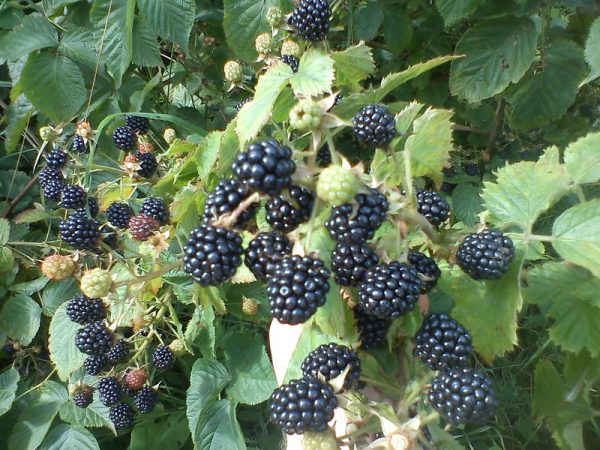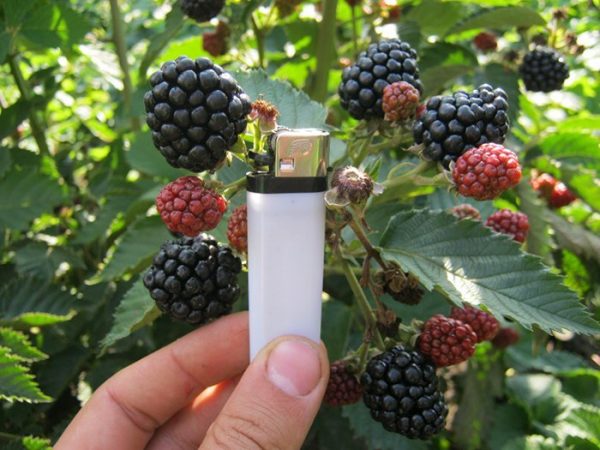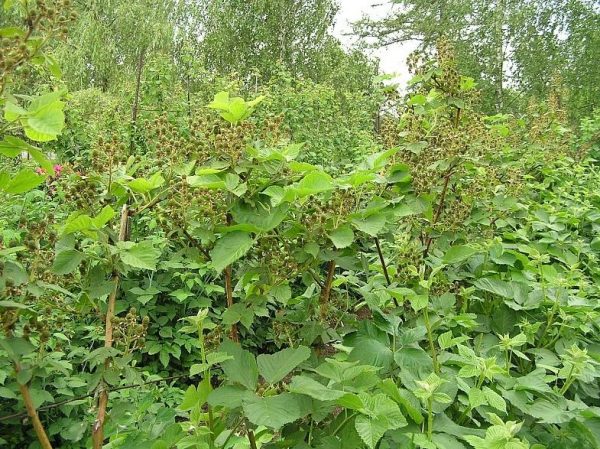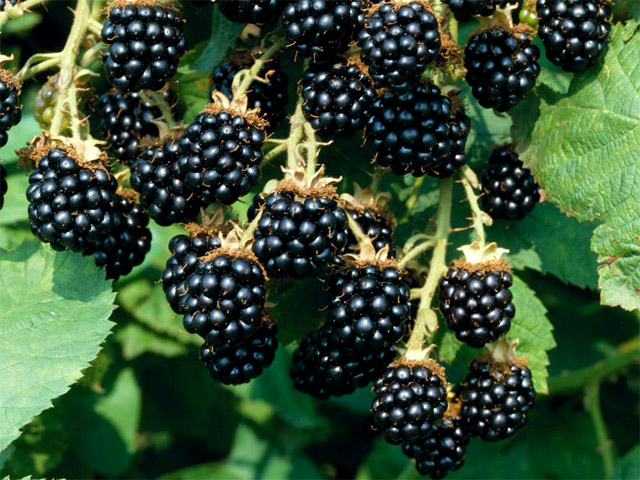Today, the assortment of blackberry seedlings in nurseries is very large. Among modern varieties, one can find all the wonders of breeding - and remontant, and of different colors, and with orange or apple flavor, and unless they themselves do not plant. But not all gardeners are in a hurry to change the old proven varieties. One of them is the blackberry variety Agavam.
Characteristics of a variety
Let's start with the description of the blackberry variety Agaveam. It is possible that the birth of the proverb is connected with the ancient Agave variety: “There are only two problems with the blackberry: first, get it, then bring it out.” This age-old "grandfather" inherited from his ancestors, wild plants, an amazing will to live and the ability to quite aggressively seize adjacent territories.
Like many other varieties of blackberry, Agaveam is from North America. There is no more accurate information about the history of its appearance, since it is a sort of popular selection. According to its shape, Agaves refers to the cumaníks - blackberries with erect shoots. Its varietal characteristics:
| Habit | The bush is powerful, tall, from 1.8 to 3 meters tall. Grows heavily, giving a lot of root offspring. |
| Shoots | Thick - erect, with drooping tops, thin can grow horizontally. Incontinuous annual shoots are green, matured - reddish-purple, with glandular pubescence. Two-year-olds - red-brown, pentahedral. Thorns are large, bent.
Leaf complex, studded along the veins. A characteristic feature of the Agave variety is that all leaf blades of a leaf come out from one point. The foliage does not drop for a long time, it can leave with the leaves under the snow. |
| Bloom | Large white flowers in racemes. Flower buds form overwintering biennial shoots. May bloom. |
| Fruiting | Abundant, 15-20 berries in each brush. Fruits are black, shiny, medium-sized, conical, 3-4 grams each. Mid-season variety, berries poured by the end of August.The taste is classic, blackberry, sweet. The duration of fruiting is up to 15 years under favorable conditions. |
| Resilience | Record frost resistance. Does not freeze when the temperature drops to -30⁰. Resistant to drought, in the absence of watering a little shallow berries. At the same time - not afraid of wet soils. Bushes do not fall out due to spring soaking. Shade-tolerant Resistant to rust, stem cancer, anthracnose. |
| Yield | Under various conditions - from 5 to 15 kg per bush. |
| Purpose of the fruit | For the fresh use, processing on jam, jams, juice. The berries are suitable for freezing and drying. |
| Transportability and curing | In the fresh form is stored for long, like raspberry. For transportation, fruits must be removed in the phase of incomplete maturity. |
These data allow us to draw conclusions about the disadvantages and advantages of the blackberry variety Agaveam. The advantages include:
- excellent winter hardiness;
- drought tolerance;
- shade tolerance;
- resistance to wetting, which allows planting agavam blackberries in the lowlands;
- disease resistance;
- yield;
- good fruit taste and versatility;
- fruit transportability;
- prolonged fruiting.
Among the shortcomings can be noted only strong spiky shoots, which makes it difficult to leave. With regard to the propensity of the blackberry Agave to “scatter” around the site, it is possible to relate to this in two ways. On the one hand, this complicates the care of plantings and requires constant monitoring. On the other hand, it makes it easy to reproduce blackberries. From one bush it is possible to breed a whole blackberry plantation for several years.

Growing blackberries agave
Blackberry seedlings Agave is best planted in the spring, so that the young plant has taken root. If you do this in the fall, it is better to place the sapling in the pit “lying down” and cover it. Otherwise, there is a risk of freezing of the shoots.
The ideal soil is light sandy loam, with a neutral reaction. If the soil is acidic, liming is required. Plot is better to choose sunny. Despite the shade tolerance of the variety, it is more productive in the sun, and in cold regions in dense shade they may not have time to ripen young-year-old shoots before winter.
A mullein is introduced into the planting pit, filled with humus, 150 grams of superphosphate, 40 grams of potash fertilizers are added. From above, everything is filled up with a layer of humus to half the volume of the pit and watered. Thus prepared planting pit will provide plant nutrition for the next three years. After that, in the spring under each bush will need to be buried in a bucket of well-rotted manure or mature compost.
After planting, seedlings are immediately cut to a height of 20-25 cm from the ground. Pristvolny circle is useful to mulch. It retains moisture in the soil and protects against weeds. As a mulch, the blackberry likes forest flooring with bark and conifer inclusions.
To plant blackberries can be in two ways: in rows or individual bushes. If there is no task to dissolve the bramble, under a bush you need to separate an area of 2 * 2 meters. The landing pattern in rows along the border is more interesting:
- 1 meter recede from the border and place seedlings with an interval of 1 meter from each other.
- Strong racks are instilled into both ends of the row (from a bar or thick reinforcement).
- Between them stretch three rows of wire: at a height of 40, 120 and 170 cm.
This way the trellis is formed. In summer, the shoots are tied to the upper and middle wires - each separately, fan, with an interval of about 25 cm. This method, firstly, allows all vines to get enough sunlight and facilitates harvesting. Secondly, this creates a barbed green hedge on the site.
In the fall, two-year-old spawn-bearing branches are cut, and the young ones are tied in a bundle, bend down to the bottom wire and are tied up. It is necessary to perform this procedure before the cold, while the shoots are not woody and still quite flexible.
Blackberry Agave is quite capable of wintering without shelter. With severe frosts (-25⁰C and below), you only need to throw a lot of snow on the bushes.
If for some reason there is no certainty that the wintering will be good, you can make a shield cover for the blackberry: two rows of wooden boards with a height of 80 cm are installed above the bushes in the form of a tent and covered with foil. From the ends, the structure closes after the onset of frost.

Pruning
In the early years, the blackberry agave does not require much effort to form. But when it comes into force, this variety begins to drive out too long vines capable of turning the plantation into a jungle. Therefore, starting from the fourth year of life, Agaves need to be cut regularly.
Except for the autumn removal of the sprouting branches, Agaves are pruned twice per season. The first pruning is carried out in the spring. After releasing overwintered vines, they are carefully examined. Live shoots have shiny brown bark; they are resilient and strong, not fragile. The frozen ones must be cut out immediately. For a good harvest, 4-6 branches are enough.
The second pruning is carried out in July on year-old shoots-substitutes by pinching - pinching the tops of 7-10 cm. For cumaníks, this is a mandatory technique that stimulates fruiting the next year. On the shoots of the second order, when they grow back, the procedure is repeated.

Diseases and pests
According to the owners of this variety, the blackberry Agave is not affected by infectious diseases, but problems of non-infectious nature may appear. With improper care, violation of the mode of dressing,the occurrence of a deficiency or excess of certain substances in the soil, blackberries can get sick.
| Battery | Symptoms of deficiency | Symptoms of excess |
| Nitrogen | Weak growth of shoots, pale foliage, which the shrub drops in the middle of summer, poor flowering and shredding of berries. | Brown spots on the leaf plates, which may begin to roll and fall. |
| Phosphorus | The leaves are dull, with a bronze sheen, turn black and fall. Flowering and ripening berries - with a delay. | Leaves first brighten, then necrosis develops, and they fall. |
| Boron | Leaf discoloration (chlorosis), dying off of the apical bud, cavities, and corking of the tissue on the berries. | Chlorosis between the veins and on the edges of the leaf plates, which twist and fall. |
| Magnesium | The sheet plate reddens, retaining the green color of the veins. Premature fall of the foliage, starting from the bottom of the shoot. | Dark, shriveled, unnaturally elongated leaves that quickly die off. |
| Calcium | The top of shoots, young leaves - yellow-green, old - green. | Close internodes, leaves grow like a fan, the gradual death of shoots. |
| Zinc | Small bronze leaves on tops, asymmetric leaf plate, small ugly fruits. | The extinction of the apical bud, blackening of the veins, the appearance of transparent areas on the leaf. |
Blackberries Agaves can suffer from root pests - the bear, the May beetles and their larvae, which often gnaw the roots of seedlings near the root collar. In general, Agaves - a strong plant, resistant to ordinary pests of blackberries and raspberries.
The attitude towards the blackberry agave today is ambiguous. Some people like this variety, someone categorically does not want to start it on their site. However, looking after the Agawam requires no more than raspberries or many other varieties of blackberry. And abundant regular crops can offset the efforts to grow this old variety.
